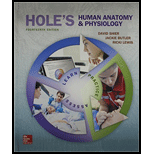
Concept explainers
To distinguish:
In-between general and special senses.
Introduction:
General senses include the receptors which are present throughout the body. They are located in the skin, muscles, bone joints and the visceral organs (exteroreceptors).
There are of various types including the receptors for receiving the sensation and feeling of touch, pressure, and pain. The second category includes the sensations for blood pressure and the pH changes in the
The receptors for the special senses include the receptors for smell, taste, hearing, body equilibrium and eye-sight.
Explanation of Solution
The differences in-between general and special senses are:
| General Senses | Special Senses |
| These receptors for these senses are present throughout the body. | The receptors for these senses are present in specific regions of the body. |
| They have sensory nerve endings for receiving the stimulus. | They consist of the bipolar neurons for sensing the stimulus. |
| They have specialized nerve endings which are called as Meissner’s corpuscles for touch and Pacinian corpuscles for sensing vibration in tissues. | There are fibers of nerves for taste and smell called as the olfactory neurons for the smell. |
| For example sensation receptors for touch, pain, and temperature. The other receptors include those for the movement and locomotion of the body, changes in blood pressure and pH. | For example smell, taste, hearing, body-equilibrium, and eye-sight. |
The general senses include the receptors for sensing and feeling of touch, pressure, and pain inside the body. The special senses include the perception of the stimulus for vision, smell, taste, and body-equilibrium.
Want to see more full solutions like this?
Chapter 12 Solutions
Combo: Hole's Human A&P with Connect Access Card
 Human Anatomy & Physiology (11th Edition)BiologyISBN:9780134580999Author:Elaine N. Marieb, Katja N. HoehnPublisher:PEARSON
Human Anatomy & Physiology (11th Edition)BiologyISBN:9780134580999Author:Elaine N. Marieb, Katja N. HoehnPublisher:PEARSON Biology 2eBiologyISBN:9781947172517Author:Matthew Douglas, Jung Choi, Mary Ann ClarkPublisher:OpenStax
Biology 2eBiologyISBN:9781947172517Author:Matthew Douglas, Jung Choi, Mary Ann ClarkPublisher:OpenStax Anatomy & PhysiologyBiologyISBN:9781259398629Author:McKinley, Michael P., O'loughlin, Valerie Dean, Bidle, Theresa StouterPublisher:Mcgraw Hill Education,
Anatomy & PhysiologyBiologyISBN:9781259398629Author:McKinley, Michael P., O'loughlin, Valerie Dean, Bidle, Theresa StouterPublisher:Mcgraw Hill Education, Molecular Biology of the Cell (Sixth Edition)BiologyISBN:9780815344322Author:Bruce Alberts, Alexander D. Johnson, Julian Lewis, David Morgan, Martin Raff, Keith Roberts, Peter WalterPublisher:W. W. Norton & Company
Molecular Biology of the Cell (Sixth Edition)BiologyISBN:9780815344322Author:Bruce Alberts, Alexander D. Johnson, Julian Lewis, David Morgan, Martin Raff, Keith Roberts, Peter WalterPublisher:W. W. Norton & Company Laboratory Manual For Human Anatomy & PhysiologyBiologyISBN:9781260159363Author:Martin, Terry R., Prentice-craver, CynthiaPublisher:McGraw-Hill Publishing Co.
Laboratory Manual For Human Anatomy & PhysiologyBiologyISBN:9781260159363Author:Martin, Terry R., Prentice-craver, CynthiaPublisher:McGraw-Hill Publishing Co. Inquiry Into Life (16th Edition)BiologyISBN:9781260231700Author:Sylvia S. Mader, Michael WindelspechtPublisher:McGraw Hill Education
Inquiry Into Life (16th Edition)BiologyISBN:9781260231700Author:Sylvia S. Mader, Michael WindelspechtPublisher:McGraw Hill Education





